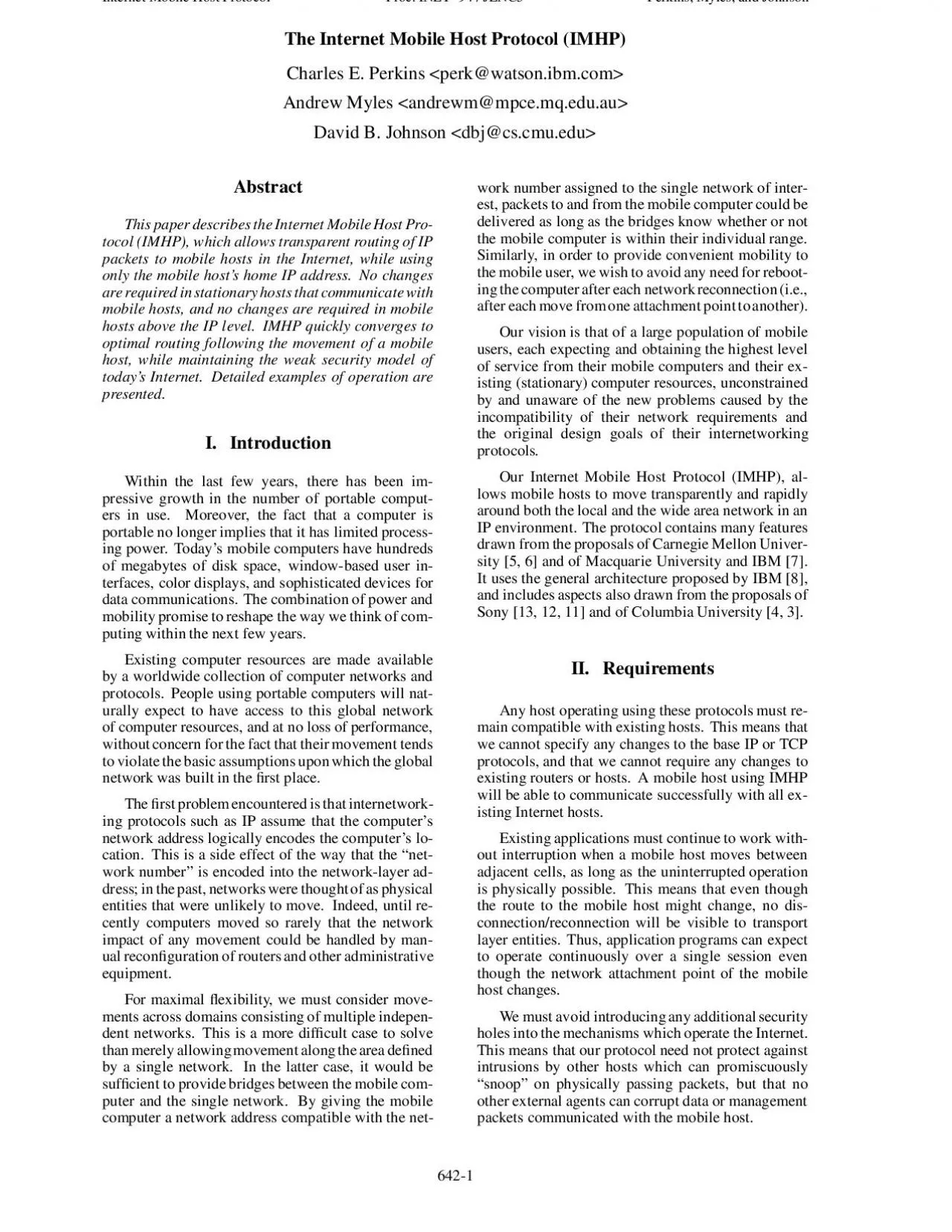

y AmobilehostistheIMHPentitythatmaymovethroughtheIPinternetworkItisassignedaconstantIPaddressonahomenetworkknownasitshomeaddressCorrespondenthostsmayalwaysusethehomeaddresstoaddresspacketstoamobi ID: 960626
Download Pdf The PPT/PDF document "IIIDenitionsThefollowingspecictermsareus..." is the property of its rightful owner. Permission is granted to download and print the materials on this web site for personal, non-commercial use only, and to display it on your personal computer provided you do not modify the materials and that you retain all copyright notices contained in the materials. By downloading content from our website, you accept the terms of this agreement.
,y, III.DeÞnitionsThefollowingspeci ctermsareusedinthispaper:NodeAdeviceinthenetworkthatimplementstheInternetProtocol,IP[10].RouterAnodethatforwardsIPdatagrams,asspec-i edin[1].Thisdoesnotincludenodesthat,thoughcapableofIPforwarding,havethatca-pabilityturnedoff,nordoesitincludenodesthatperformIPforwardingonlyinprocessingIPSourceRouteoptions.HostAnynodethatisnotarouter.MobilehostAhostthatmayconnecttotheInternetinnetworksotherthanitsownhomenetwork,whilestillusingitshomeaddress.StationaryhostAhostthatisnotamobilehost.CorrespondenthostAhostcommunicatingwithan-otherhost.Thistermisusedwhenitisnotrele-vantwhetherahostisamobilehostorastationaryhost.HomeaddressAnaddressusedtoidentifyamobilehost,nomatterwhereitmaycurrentlybelocated.HomenetworkThe(logical)networkonwhichamobilehostshomeaddressresides.Care-ofaddressAnaddressthatde nesthelocationofamobilehostatsomeparticularinstantoftime.Packetsaddressedtothemobilehostwillarriveatthisaddress.ForeignagentAnagentthatoffersacare-ofaddressforvisitingmobilehosts,anddeliversarrivingpacketsaddressedtooneofthesemobilehostslocallytothemobilehost.HomeagentAnagentthatmaintainsinformationaboutthecurrentcare-ofaddressofeachofthemobilehostsitiscon guredtoserve,andthatfor-wardspackets(addressedtoanyofthesemobilehosts)tothecare-ofaddressforthatmobilehost.TriangleroutingAsituationinwhichacorrespon-denthostspacketstoamobilehostareforwardedthroughthemobilehostshomeagent,ratherthanfollowingtheshortestpathdirectlytothemobilehost.CacheagentAnagentthatcachesthelocationofoneormoremobilehostsandforwardspacketstothesemobilehosts.IV.BasicOperationIV.A.Infrastructure AmobilehostistheIMHPentitythatmaymovethroughtheIPinternetwork.ItisassignedaconstantIPaddressonahomenetwork,knownasitshomeaddress.Correspondenthostsmayalwaysusethehomeaddresstoaddresspacketstoamobilehost.Amobilehosthasahomeagent,whichisattachedtoitshomenetwork.Eachhomeagentmaintainsalistknownasahomelist,whichidenti esthosemobilehoststhatitiscon guredtoserve,alongwiththecur-rentlocationofeachofthesemobilehosts,ifknown.IMHPmakesnoassumptionsaboutwhethermobilehostsusewiredorwirelessinterfacesforconnectiontothenetwork.Thehomenetworkcon gurationmaycorrespondtoaphysicalsubnetoravirtualsubnet.Forexample,thehomenetworkmaybeaphysicalnetworkcon-nectedtotheInternetthroughanIProuter,whichisresponsibleforadvertisingconnectivitytothehomenetwork.Thehomeagentmaybeaseparatenodeattachedtothephysicalhomenetwork,ormaybeimplementedbythesamenodeastheIProuter.Alter-natively,thehomenetworkmaybeavirtualnetwork,whichmeansthatmobilehostsneverconnectdirectlytotheirhomenetwork.Theseexamplecon gurationsareillustratedinFigure1.Othercon gurationsarealsopossibl
einwhichthehomeagentisreplicatedordistributed,orthehomenetworkisdistributed,butsuchcon gurationsarenotdiscussedinthispaper.Whenamobilehostconnectstothenetwork,itmustperformaregistrationprocessbeforepacketswillbedeliveredtoit.Themechanismsusedtoiden-tifythatthemobilehosthasconnectedtotheanewnetworkdependonthesub-networklayertechnologybeingused.Eitherthepotentialforeignagentorthehomeagentmayrejectaregistrationattempt.Typi-callythegroundsforrejectionwillbesecuritybased,althoughotherfactorssuchasloadmayalsobeconsid-ered.Duringtheregistrationprocess,themobilehostwillspecifywhetherornotitsnewlocationshouldbemadeavailabletootherIMHPentitiesforthepurposesofrouteoptimization(SectionIV.C). home agent Router andhome agent Internetwork Physicalhome network InternetworkVirtualhome network InternetworkRouter Physicalhome networkHome agent Figure1ExamplehomenetworkconÞgurations InternetMobileHostProtocolProc INET94/JENC5Perkins Myles andJohnson Eachforeignagentmaintainsalistknownasavisitorlist,whichidenti esthosemobilehoststhatarecurrentlyregisteredwithit.Theaddressoftheforeignagent,suppliedasthemobilehostscare-ofaddress,de nesthemobilehostscurrentlocation.Thecombinationofahomeaddressandacare-ofaddressisknownasabinding.Thebindingbetweenamobilehostandaforeignagentisalsotaggedbyalogicaltimestamp,whichisgeneratedbythemobilehostbyincrementingitsprevioustimestampvalueeachtimeitattemptstoregisterwithaforeignagent.Thetimestampisalwaysincludedwithanybindingstoredorpassedthroughthenetwork.Timestampsmaybeusedtocomparebindingsforagivenmobilehosttodeterminewhichisthemostrecent.Theregistrationprotocolensuresthatamobilehostshomeagentlearnsaboutthenewbindingofanymobilehostitserves.Theregistrationprotocolalsonoti esthepreviousforeignagent(s)thatthemobilehostshasmoved.Thismechanismallowsthepre-viousforeignagenttoforwardpackets,destinedtoamobilehostthathasmovedelsewhere,tothemobilehostsnewlocation.Insteadofnotifyingtheprevi-ousforeignagentofthemobilehostsnewlocation,theregistrationprotocolmaysimplynotifyitthatthemobilehosthasmoved,withoutrevealingitsnewlo-cation;inthiscase,thepreviousforeignagentsimplyremovesthemobilehostfromitslistofvisitingmobilehosts.Theexchangeofpacketsusedbytheregistra-tionprotocolisillustratedinFigure2foratypicalIMHPcon guration.Anynodemaycachethecurrentbindingofamobilehostinordertobeabletoforwardpacketsdirectlytothatmobilehost.Amobilehostsprevi-ousforeignagent(functioningasacacheagent)maycachethenewbindingofthemobilehostfromtheno-ti cationsentduringthenewregistration;thiscacheentryservesasaforwardingpointertoallowpack-etsarrivingatthemobilehostsoldlocationtobefor- Register with home agentHome agent No
tify previousforeign agentPreviousforeign agent Register with foreign agentForeign agent Mobile host Figure2Exampleregistrationprocesswardedtoitsnewlocation.AnycorrespondenthostthatimplementsIMHP(forexample,anothermobilehost)mayalsofunctionasacacheagentbysimilarlymaintainacacheofbindingsforothermobilehosts;theIMHPmanagementprotocolsendsaBindingNo-tifypacket(SectionV.A)tocorrespondenthostsasneededtobuildandmaintainthesecaches.ThecacheofbindingsmaintainedbyacacheagentisknownaslocationcacheEachentryinthevisitorlistorlocationcacheofanodehasatimeoutassociatedwithit,ensuringthatastaleentrydoesnotpersistforever.Thetimeoutisresetwhenevertheentryisrecon rmedbytheIMHPmanagementprotocolorbytheregistrationprotocol.Themobilehostisresponsibleforensuringthatitsvisitorlistentryinitscurrentforeignagentisnottimedout.Acacheagentmayactivelyattempttorecon rmbindingsinitslocationcacheusingtheIMHPmanage-mentprotocol.Activerecon rmationmethodsmaybeappropriatewhenalocationcacheentryisusedoftenandatimeout(alongwiththesubsequentrediscoveryprocess)woulddisruptcommunications.Thenoti cationtoamobilehostspreviousfor-eignagentsmustbesentreliably,becauseotherwisepacketsmightbelostuntilthepreviousforeignagenttimesoutitsvisitorlistentryforthemobilehost.Thenoti cationisthusperiodicallyretransmittedeitheruntilitisacknowledgedoruntilthepreviousforeignagentcanbeassumedtohavetimedoutitsvisitorlistentryforthemobilehost.Thetimeoutperiodthataforeignagentusesforavisitorlistentryisestablishedbynegotiationwhenamobilehostregisterswiththeforeignagent.Whenamobilehostisconnectedtoitsphysicalhomenetworkitmay,afternotifyingitshomeagent,reverttooperatingasahostusingconventionalproto-colswithoutanyIMHPoverheads,ifcertainminimalconditionsaremet.Mostnotably,whenamobilehostdepartsfromitshomenetwork,anyARPcacheentriesforthemobilehoststoredatexistingnodesonthehomenetworkmustbeupdated.ThiscanbedonebyhavingthehomeagentsendoutanARPreplypacketonbehalfofthemobilehost,specifyingthatthehomeaddressofthemobilehostistobeassociatedwiththeMACaddressofthehomeagent.ThisARPreplyisknownasagratuitousARP.Foreignagents,homeagents,andmobilehosts,althoughdescribedseparatelyinthissection,maybecombinedtogetherwithinthesamenodeformanypurposes.TheIMHPmanagementprotocoldiscussedinthissectionisdescribedmorefullyinSectionV.A.IV.B.PacketRouting IMHPentitiesmustdirectpacketsdestinedtoamobilehosttoitscurrentknownlocation(i.e.,care-ofaddress).IMHPentitiessendpacketstoamobilehostscurrentlocationusingtunneling.Asageneralrule,tunnelinginvolvestheuseofanencapsulation InternetMobileHostProtocolProc INET94/JENC5Perkins Myles andJohnson protocol.AllIMHPentitiesmustsupportthedefaultIMHPtunnelingpr
otocoldescribedinSectionV.B.IMHPestablishesafewrulesforforwardingpack-ets.Theseruleshelpensurethatoptimalroutesareusedwhenpossible.Ingeneral,anodeuseswhat-everlocationcache,visitorlist,homelist,andnormalroutingtableinformationithasavailabletoforwardpackets,withasmallnumberofrestrictions.Ifnoneoftherulesbelowapplytoaparticularpacket,thennormalIProutingrulesarefollowed.ThefollowingtwobasicrulesapplytoallIMHPnodes,whichallowforthedeliveryofpacketsad-dressedtothesenodesandforthedecapsulationoftunneledpackets:Ifanodereceivesatunneledpacket,andthedes-tinationofthetunnelisoneofthenodesownaddresses,thenthenodedecapsulatesthepacketandcontinuesprocessingthepacketaccordingtotheremainingforwardingrules.Ifanodereceivesapacketthatisnottunneled,andthedestinationofthepacketisoneofthenodesownaddresses,thenthenodepassesthepackettohigherlayerprotocolsforprocessing.Ahomeagentwillgenerallyhaveacurrentau-thenticatedbindingforthemobilehostsinitshomelist.Ahomeagentmustalsoserveasacacheagentforthesemobilehosts,andmaybeaforeignagentforthemobilehostsitservesaswell.Thesepropertiesservetode nethefollowingforwardingrulesforahomeagent,whendealingwithpacketsaddressedtothemobilehostsinitshomelist:Ifahomeagentreceivesatunneledpacketforamobilehostinitshomelist,inwhichtheorig-inaldestinationisthesameastheencapsulateddestination,thenthehomeagentdecapsulatesthepacketandcontinuesprocessingthepacketac-cordingtotheremainingforwardingrules.Ifahomeagenthasavisitorlistentryforthemobilehost,thenthehomeagentdeliversthepacketlocallytothenetworkinterfaceindicatedbythevisitorlistentry.Ifahomeagenthasalocationcacheentryforthemobilehost,thenthehomeagenttunnelsthepackettothecare-ofaddressindicatedinthelo-cationcacheentry,subjecttotherestrictioninthefollowingrule.Ahomeagentmustnevertunnelapackettoaforeignagentifthepacketwasjusttunneledtothehomeagentfromthatsameforeignagent.Thisruleavoidsloopingbetweenahomeagentandaforeignagentthatnolongerthinksitservessomemobilehost.Thehomeagentmayalsoundertakeappropriateactions(hereunde ned)tofurtherhandlethepacketorlocatethemobilehost.Ifahomeagentdoesnothavealocationcacheen-tryoravisitorlistentryforthedestinationmobilehost,furtheractionisunde ned.Thehomeagentmayinthiscaseundertakeappropriateactionstofurtherhandlethepacketorlocatethemobilehost.Foreignagentsandcacheagentsuseforwardingrulesthataresimilartothoseusedbyahomeagent.Thedifferencesfromtherulesusedbyahomeagentareprimarilyduetothefactthataforeignagentoracacheagentmightnothaveanauthenticatedbindingforthemobilehost,ifthatagentisnotalsothehomeagentservingthatmobilehost.Thefollowingfor-wardingrulesapplytopacketsreceivedbyaforeignagentoracacheagent:Ifaforeignagentrec
eivesatunneledpacket,andtheforeignagenthasanentryinitsvisitorlistforthepacketsdestinationafterdecapsulatingthepacket,thentheforeignagentdeliversthepacketlocallytotheinterfaceindicatedbythevisitorlistentry.Ifaforeignagentreceivesapacket,andthefor-eignagenthasanauthenticatedvisitorlistentryforthepacketsdestination,thentheforeignagentdeliversthepacketlocallytotheinterfaceindi-catedbythevisitorlistentry.Ifacacheagentreceivesadatapacket(notanIMHPmanagementpacket),andthecacheagenthasalocationcacheentryforthepacketsdesti-nation,thenthecacheagenttunnelsthepackettothecare-ofaddressindicatedinthelocationcacheentry.Ifacacheagentoraforeignagentreceivesatunneledpacket,andthecacheagentorforeignagentisunabletoforwardthepacketusingtheaboverulesafterdecapsulatingthepacket,thenthecacheagentorforeignagenttunnelsthepackettothemobilehostshomeagentbysendingthepacketwithboththeoriginaldestinationandtheencapsulateddestinationsettothemobilehostshomeaddress.ThephilosophyofIMHPistoperformlazyup-datingoflocationcaches,sincecachedbindingsforamobilehostneednotbeupdateduntiltheyareused.Ifastalebindingisused,thepacketwillexperiencenon-optimalroutinguntilthestalebindingisupdated,butthenaturalactionofIMHPentitiescausesbind-ingstobeupdatedassoonaspossiblewhenevertheyareinuse.IfoneIMHPentitydiscoversthatanotherIMHPentitymightbeholdingincorrectinformationaboutthelocationofamobilehost,itshouldattempttocorrecttheotherIMHPentity.Theonlyexceptionstothisrulearethatamobilehostusuallyattemptstonotifyitspreviousforeignagentthatithasmoved,andamobilehostalwaystellsitshomeagentthatithasmoved.Forexample,ifanIMHPentityreceivesapacketthatneedstobetunneledtoamobilehost,itmaycon-cludethatthesource(thesourceoftunnelincaseoftunneledpackets)doesnothaveacorrectbindingforthedestinationmobilehost.TheIMHPentityshouldreturnanIMHPBindingNotifyprotocolpacketcon-tainingacurrentbindingtotheIMHPentitythathasthesuspectedincorrectbinding,asillustratedinFig- ,y, VI.A.MobileHosttoMobileHost Figure6illustratesthebasicoperationwhenamobilehost,MH1,withinrangeofaforeignagent,FA1,havingahomeagent,HA1,wantstocommuni-catewithanothermobilehost,MH2,withinrangeofaforeignagent,FA2,havingahomeagent,HA2.ThefollowingoperationsareshowninFigure6:1.MH1andMH2bothregisterwiththeirforeignagents(FA1andFA2,respectively)andnotifytheirhomeagents(HA1andHA2,respectively),oftheirnewbindings.2.SupposeMH1wantstosendapackettoMH2,andMH1doesnothaveabindingcachedforMH2.MH1transmitsthepacketrelyingonexistingroutingprotocols,usingFA1asitsdefaultrouter.ThepacketiseventuallyreceivedbyMH2shomeagent,HA2,whichtunnelsthepackettoMH2sforeignagent,FA2.WhenFA2receivesthetun-neledpacket,itdecapsulatesitanddel
iversitlocally.3.WhenHA2receivesandthentunnelsthepacket,italsosendstothesource(here,MH1)anIMHPBindingNotifypacketcontainingMH2sbind-ing,asMH1seemsnottohaveabindingcachedforMH2.WhenMH1receivestheIMHPman-agementprotocolpacketcontainingthebindingforMH2,itmayneedtoauthenticatethebindingusingmethodsdescribedinSectionIV.4.AssumingMH1issatis edthatthereceivedbind-ingisgenuine,MH1cantransmitfuturepacketsforMH2bytunnelingthemdirectlytoMH2scurrentforeignagent,FA2.Aclosetooptimumrouteisthusestablished.VI.B.MobileHostMovement Figure7extendstheexampleofFigure6toshowthemovementofMH2toanewlocation.Thefollow-ingoperationsareshowninFigure7:1.MH2detectsthatitisconnectedtoanewnetwork.Theregistrationprotocolisusedtoregisterwithanewforeignagent,FA3,andnotifyMH2shomeagent,HA2.2.MH2spreviousforeignagent,FA2,isalsoreli-ablynoti edofMH2snewbinding.Thenoti -cationtoFA2mayincludeauthenticationinfor-mation. HA2 MH2 FA2 MH1 FA1 MH2 FA2 MH1 HA2 MH2 FA2 MH1 RegistrationRegistrationFigure6Mobilehosttomobilehostcommunication FA3 MH1 FA2 MH2 FA3 MH1 RegistrationBinding Notify1. MH2 FA3 3.4. HA2 FA3 Figure7Mobilehostmovement3.SupposeMH1wantstosendapackettoMH2.MH1tunnelsthepackettowhereitbelievesMH2islocatedatFA2.FA2forwardsthepackettoFA3,usingthebindingthatitreceivedintheno-ti cationfromMH2snewregistrationwithFA3.Finally,FA3decapsulatesthepacketanddeliversitlocallytoMH2.4.FA2recognizesthatMH1musthaveanoldbind-ingforMH2,sinceotherwiseMH1wouldnothavetunneledthepackettoFA2.FA2thussendsMH1aBindingNotifypacketnotifyingitofMH2snewbindingatFA3.MH1mayneedtoauthenticatethisbindingbeforeusingit.5.Oncethenewbindingisauthenticated,futurepacketstoMH2aretunneleddirectlytoFA3.HA1isnotinvolvedinanyofthemessagesrelatedtothemovementofMH2andthesubsequentupdateofbindingsheldbyMH1.VI.C.StationaryHosttoMobileHost Figure8illustratesthecaseinwhichastationaryhost,SH,whichdoesnotimplementIMHP,wantstocommunicatewithamobilehost,MH,withinrangeofaforeignagent,FA,havingahomeagent,HA.ThefollowingoperationsareshowninFigure8:1.MHdetectsitisconnectedtoanewnetworkandusestheregistrationprotocoltoregisterwithanewforeignagent,FA,andtonotifyitshomeagent,HA.2.SupposeSHwantstosendapackettoMH.SinceSHdoesnotimplementIMHP,itdoesnothaveMHslocationcached.SHthereforesendsthepackettoMHusingconventionalprotocols.ThepacketiseventuallyreceivedbyHA,whichtun-nelsittheMHsknownlocation,FA.FAdecap-sulatesthepacketanddeliversitlocallytoMH. MH FA MH FA HA SH Figure8Stationaryhosttomobilehostcommunications InternetMobileHostProtocolProc INET94/JENC5Perkins Myles andJohnson 3.WhenHAreceivesthepacketfromSH,itsendsaBindingNotifytothesource,SH.SinceSHdoesnotimplementIMHP,HAmayeventuallysurm
isethattheBindingNotifypacketsitissendingtoSHarehavingnoeffect;HAsbackoffalgorithmwillcauseitsendanewBindingNotifypackettoSHonlyinfrequently,notsendingoneatallformostnewpacketsitreceivesfromSHforMH.ThepacketsfromSHwillcontinuetofollowatriangleroutingpath,whichislikelytobenon-optimum.VI.D.RoutingLoopResolution Suppose,perhapsbecauseofsomeincorrectim-plementationoftheprotocol,thattwoormorecacheagentshadlocationcacheentriesformingaloopforaparticularmobilehost.Considerthecaseofthreecacheagents(CA1,CA2,andCA3)thathavesuchbindingsintheirlocationcachesforamobilehost,MH.TheresolutionoftheloopisillustratedinFig-ure9.ThefollowingoperationsareshowninFigure9:1.IfCA1tunnelsapacketdestinedforMHtoCA2,CA2willtunnelthepackettoCA3.2.WhenCA3receivesthepacket,itwilltunnelthepacketonagaintoCA1.3.TheloopisbrokenbytheBindingNotifypacketsthataresenttothesourceofeachtunnel.CA2sendsaBindingNotifytoCA1,andCA3sendsaBindingNotifytoCA2.4.Finally,CA1sendsaBindingNotifytoCA3.EachforeignagentthatreceivesaBindingNo-tifypacketusesthelogicaltimestamptodecidewhetheritscurrentbindingisoutofdate.Ifso,theforeignagentreplacesthislocationcacheen-try,possiblyafterauthenticatingthenewbinding.VII.ExtensionsVII.A.Popups SomeareasoftheInternetmaynothaveIMHPfacilities,suchasforeignagents,availableforuse.Whenthissituationarises,amobilehostmayuseatechniquecalled[3]tomaintainconnectiv-ity.ThepopupmethodappliedtoIMHPrequiresthemobilehosttoacquireatemporarylocaladdressfromalocaladdressserver(forexample,aserverimple- CA1 CA2 2. CA1 CA1 CA3 CA2 CA3 Figure9RoutingloopresolutionmentingDHCP[2])andtothenreporttheallocatedaddresstoitshomeagentasitscare-ofaddress.Themobilehost,ineffect,actsasitsownforeignagent,usingthistemporaryaddress.Ifthehomeagentisallowedtodistributethisbind-ingtoothernodesinBindingNotifymessages,opti-malroutingofpacketstothemobilehostusingthistemporaryaddressispossible.However,whenthemobilehostsubsequentlymovestoanewnetwork,communicationtothemobilehostmightbelostforuptothetimeoutperiodonthelocationcacheentry.Thismovementofthemobilehostwouldappeartothecor-respondenthostsasacrashoftheforeignagent,sincenonodewouldthenberespondingtothistemporaryaddress.Thisproblemmaybesolvedbyinsteadnotdistributingthisnewbindingtonodesotherthanthemobilehostshomeagent,butthiswouldrequireallpacketstothemobilehosttobeforwardedthroughthehomeagent,resultinginroutingthatislikelytobenon-optimal.Ineithercase,truemobilefunctionalitydependsontheabilityofthemobilehosttodetectautomaticallythatithasmoved.Withoutarealforeignagent,thismightbedif cult,ormightrequireuserintervention;onemethodthatmightbeusedwouldbetomonitorthesourceaddressofreceivedbroadcastpacketssuchasARPr
equests.VII.B.IntermediateCacheAgents Differenttypesofintermediateagentshavebeensuggestedbyanumberofproposals[12,5,7]asawayofoptimizingroutesbetweenstationaryhostsandmobilehosts.InIMHP,thefunctionalityofacacheagentmayalsobeimplementedinintermediateroutersnototh-erwisefunctioningashomeagents,foreignagents,ormobilehosts.WhensuchanintermediaterouterreceivesapacketfornormalIPforwarding,itcanin-steadthentunnelthepacketdirectlytotheforeignagentcurrentlyservingthedestinationmobilehost.IntermediateroutersservingascacheagentsdiscovernewbindingsbysnoopingonIMHPBindingNotifypacketsasitforwardsthem.VIII.SummaryandConclusionsWehaveproposedmechanismsusefulforenablingcomputerstomaintainnetworkconnectionsevenastheymoveaboutfromonelocationtoanother.Themodelwehavedeveloped tsnaturallywithintheexistingInternetandallowsmobilehoststocommu-nicatewithexistingcomputingresourceswithoutre-quiringanychangestoexistingnodes.Wehavetrans-formedtheproblemofprovidingseamlessconnec-tivitytomobilehosts,intoaproblemofmaintainingdynamiclocationinformationforthemobilehostatthehomeagentandoptionallyatcacheagents.Byenablingnewhoststoalsocachebindingsformobilehosts,weprovidemechanismsforbetterroutingwhichbypassesthedefaultrelianceonroutes InternetMobileHostProtocolProc INET94/JENC5Perkins Myles andJohnson throughthehomeagent.Thus,asmorenewequip-mentisdeployedthatincorporatesthesetechniquesforavoidingtrianglerouting,theroutinginef ciencyassociatedwithmaintainingnetworkconnectionswithmobilehostswilldisappear.Thisnewfeature,whichisroughlyanalogoustothecurrentICMPHostRedi-rectmessage,requirescarefulauthentication,sinceotherwiseamalicioususermightissueanintention-allyincorrectbindinginordertodisruptorusurpadatastreamintendedforamobilehost.Theuserofthemobilehostneednotperformanyunusualproceduresoroperationstoachievetheben-e tsofseamlessmobilitywhereverallowedbythephysicsofthenetworkmedium.Byprovidingmecha-nismsfordistributingthemobilehostscare-ofaddressjusttotheplaceswhereitisinuse,IMHPeliminatesthelikelihoodthatthehomeagentwouldbeabottle-neckintheoperationofthehomenetwork.Schemesthatrelyonthehomeagentfortransmissionofev-erypacketdestinedtothemobilehostarelikelytoprovidepoorerperformance,presentextraloadtotheinterconnectednetworks,andoffertraf ccharacteris-ticstiedtothevagariesoftheprocessingloadcarriedbythehomeagent.WehavetriedtotakegreatcaretomakesurethatthemaintenanceofthedistributedbindingsinIMHPlocationcachesissimple,effective,andreliable.AcknowledgmentsWegratefullyacknowledgetheinteractionswehavehadwithAlQuirt,KannanAlagoppan,andoth-ersintheIETFMobileIPWorkingGroupwhohavehelpedshapetheideaswithinthisproposal.References[1]R.BradenandJ.Pos
tel.RequirementsforInter-netGateways.RFC1388,June1987.[2]RalphDroms.DynamicHostCon gurationPro-tocol.RFC1531,October1993.[3]J.Ioannidis,D.Duchamp,G.Maguire,andS.Deering.ProtocolsforMobileInternetwork-ing.InternetDraft,June1992.[4]JohnIoannidis,DanDuchamp,andGeraldQ.MaguireJr.IP-basedProtocolsforMobileInternetworking.InProceedingsoftheSIG-COMM91Conference:CommunicationsAr-chitectures&Protocols,pages235245,1991.[5]DavidB.Johnson.TransparentInternetRoutingforIPMobileHosts.InternetDraft,July1993.[6]DavidB.Johnson.ScalableandRobustInter-networkRoutingforMobileHosts.InProceed-ingsofthe14thInternationalConferenceonDis-tributedComputingSystems,June1994.[7]AndrewMylesandCharlesPerkins.MobileIP.InternetDraft,August1993.[8]C.PerkinsandY.Rekhter.SupportforMobilitywithConnectionlessNetworkLayerProtocols.InternetDraft,November1992.[9]J.Postel.InternetControlMessageProtocol.RFC792,September1981.[10]J.Postel.InternetProtocol.RFC791,September[11]F.Teraoka,KimClaffy,andM.Tokoro.Design,implementation,andevaluationofvirtualinter-netprotocol.InProceedingsofthe12thInter-nationalConferenceonDistributedComputingSystems,pages170177,June1992.[12]FumioTeraoka.VIP:IPExtensionsforHostMi-grationTransparency.InternetDraft,July1992.[13]FumioTeraoka,YasuhikoYokote,andMarioTokoro.ANetworkArchitectureProvidingHostMigrationTransparency.InProceedingsoftheSIGCOMM91Conference:Communica-tionsArchitectures&Protocols,pages209220,September1991.AuthorInformationCharlesPerkinsreceivedtheB.A.degreeandtheM.E.E.degreefromRiceUniversity,andtheM.A.degreefromColumbiaUniversity.Since1984,hehasworkedforIBMonavarietyofprojectsrelatedtonetworks,multiprocessors,andmobilecomputing.HeisamemberofUSENIX,IEEE,andACM.AndrewMylesreceivedtheB.Sc.degreeinandtheB.E.(Electrical)degreewithFirstClassHon-oursandUniversityMedalin1986fromtheUniversityofSydney.From1987to1989heworkedatHewlettPackardLaboratoriesinBristol,UKbeforereturningtoAustralia.HeiscurrentlyworkingtowardsthePh.D.degreeatMacquarieUniversity,withaspecialinterestinMACandnetworklayerprotocolsforwire-lessandmobilenetworks.HeisamemberoftheIEEECommunicationsSociety.DavidJohnsonreceivedtheB.A.degreeincom-puterscienceandmathematicalsciencesin1982,andtheM.S.andPh.D.degreesincomputersciencein1985and1990,respectively,allfromRiceUniver-sity.HeiscurrentlyanAssistantProfessorofCom-puterScienceatCarnegieMellonUniversity,wherehehasbeensince1992.PriortojoiningthefacultyatCarnegieMellon,hewasaResearchScientistandLec-tureratRiceUniversityforthreeyears.Hisresearchinterestsincludenetworkprotocols,distributedsys-tems,andoperatingsystems.Dr.JohnsonisamemberoftheIEEEComputerSociety,IEEECommunicationsSociety,ACM,USENIX,andSi